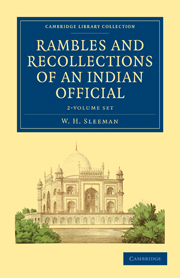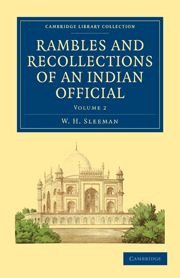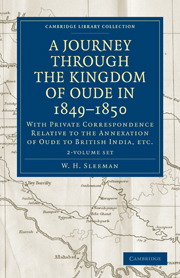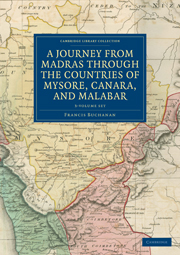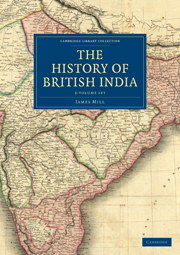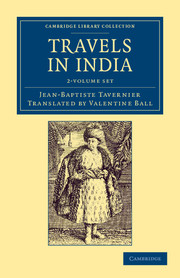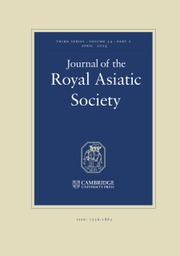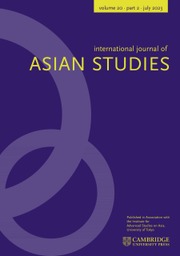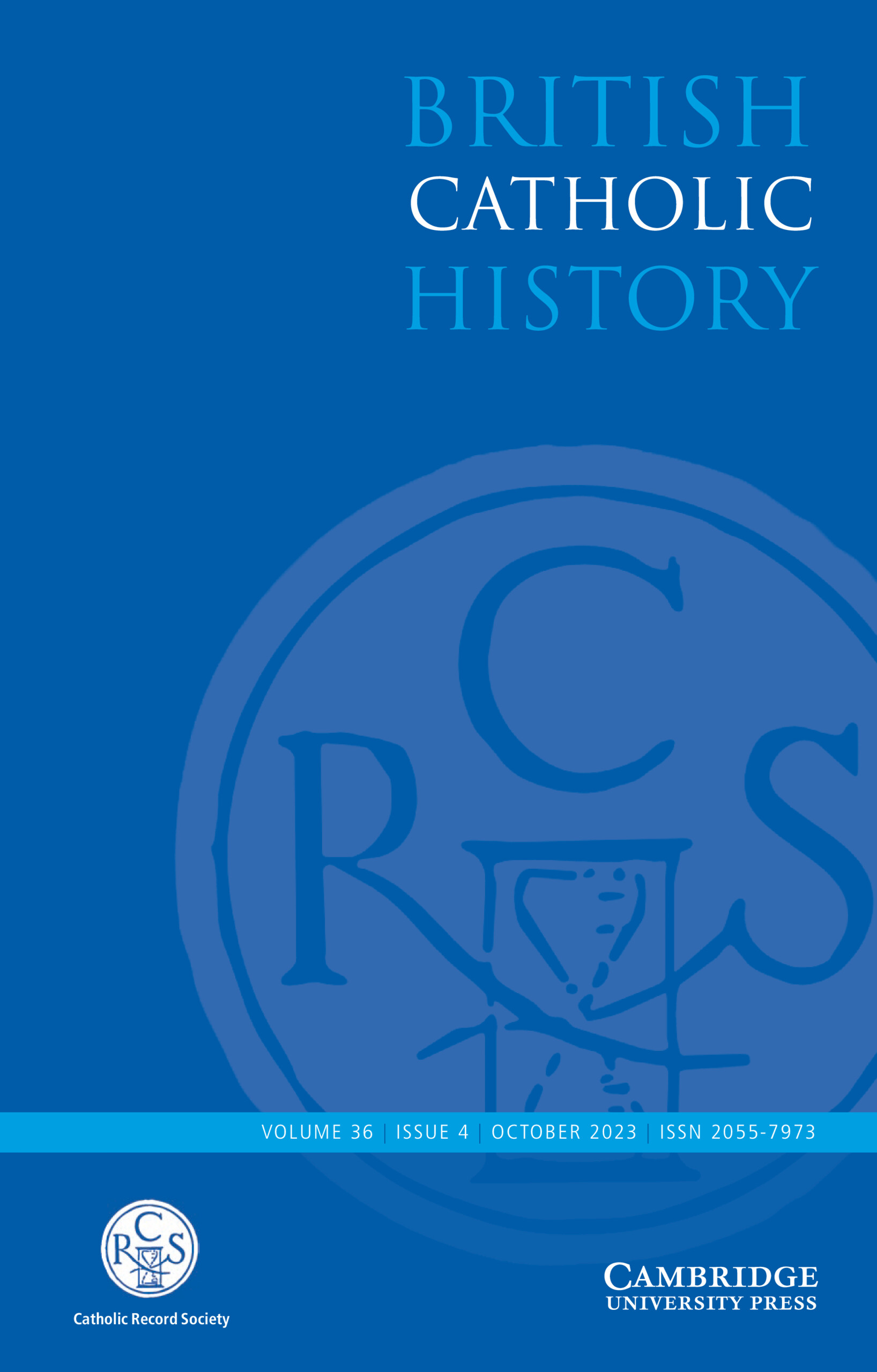Rambles and Recollections of an Indian Official
2 Volume Set
Part of Cambridge Library Collection - South Asian History
- Author: W. H. Sleeman
- Date Published: March 2011
- availability: Available
- format: Multiple copy pack
- isbn: 9781108051002
Multiple copy pack
Looking for an inspection copy?
This title is not currently available on inspection
-
Lieutenant-Colonel William Henry Sleeman (1788–1856) spent his entire career in India, as an army officer and later as a magistrate and resident. He was best known for his fight to suppress the activities of 'thugs', bands of criminals who attacked, robbed and often murdered innocent travellers. By the time of the publication of this two-volume work in 1844, Sleeman had lived in India for more than thirty years. In Volume 1, he draws on his travels and experiences, and in 48 chapters discusses myriad aspects of Indian life, including Hinduism, local festivals and folklore, natural history and disease. In Volume 2 Sleeman examines many issues related to governance, such as land, tax, military discipline and the justice system. The work includes plates of some of the spectacular buildings that he visits.
Customer reviews
Not yet reviewed
Be the first to review
Review was not posted due to profanity
×Product details
- Date Published: March 2011
- format: Multiple copy pack
- isbn: 9781108051002
- length: 1027 pages
- dimensions: 323 x 250 x 70 mm
- weight: 1.75kg
- contains: 32 b/w illus.
- availability: Available
Table of Contents
Volume 1: Dedication
1. Annual fairs held upon the banks of sacred streams in India
2. Hindoo system of religion
3. Legend of the Nerbudda River
4. A suttee on the Nerbudda
5. Marriages of trees. The tank and the plaintain. Meteors. Rainbows
6. Hindoo marriages
7. The purveyance system
8. Religious sects. Self-government of the castes. Chimney-sweepers. Washerwomen. Elephant-drivers
9. The great Iconoclast. Troop routed by hornets. The Ranee of Gurba. Hornets' nest in India
10. The peasantry and the land settlement
11. Witchcraft
12. The silver tree, or kulpa briksha. The Singhara, or trapa bispinosa, and the Guinea worm
13. Thugs and poisoners
14. Basaltic cappings of the sandstone hills of central India. Suspension bridge. Prospect of the Nerbudda valley. Deification of a mortal
15. Legend of the Sauger Lake. Paralysis from eating the grain of the Lathyrus sativus
16. Suttee tombs. Insalubrity of deserted fortresses
17. Basaltic cappings. Interview with a native chief. A singular character
18. Birds' nests. Sports of boyhood
19. Feeding pilgrims. Marriage of a stone with a shrub
20. The men-tigers
21. Burning of Deoree by a freebooter. A Suttee
22. Interview with the Rajah who marries the stone to the shrub. Orders of the Moon and the Fish
23. The Rajah of Orcha. Murder of his many ministers
24. Corn dealers. Scarcities. Famines in India
25. Epidemic diseases. Scape-goat
26. Artificial lakes in Bundelcund. Hindoo, Greek, and Roman faith
27. Blights
28. Pestle and mortar sugar-mills. Washing away of the soil
29. Interview with the chiefs of Jansee. Disputed succession
30. Haunted villages
31. Interview with the Rajah of Duteea. Fiscal errors of statesmen. Thieves and robbers by profession
32. Sporting at Duteea. Fidelity of followers to their chiefs in India. Law of primogeniture wanting among Mahomedans
33. Bhoomeeawut
34. The suicide. Relations between parents and children in India
35. Gwalior plain once the bed of a lake. Tameness of peacocks
36. Gwalior and its government
37. Contest for empire between the sons of Shah Jehan
38. Ourungzebe and Moorad defeat their father's army near Ojeun
39. Dara marches in person against his brothers, and is defeated
40. Dara retreats towards Lamore. Is robbed by the Jats. Their character
41. Shah Jehan imprisoned by his two sons, Ourungzebe and Moorad
42. Ourungzebe throws off the mask, imprisons his brother Moorad, and assumes the government of the empire
43. Ourungzebe meets Shoojah in Bengal and defeats him, after pursuing Dara to the Hyphasis
44. Ourungzebe imprisons his eldest son. Shoojah and all his family are destroyed
45. Second defeat and death of Dara, and imprisonment of his two sons
46. Death and character of Ameer Jumla
47. Reflections on the preceding history
48. The great diamond of Kohinoor. Volume 2:
1. Pindaree system. Character of the Mahratta administration. Causes of their dislike to the paramount power
2. Dholepore, capital of the Jat chiefs of Gohud. Consequence of obstacles to the prosecution of robbers
3. Influence of electricity on vegetation. Agra and its buildings
4. Noor Jehan, the aunt of the Empress Noor Bahul, over whose remains the Taj is built
5. Father Gregory's notion of the impediments to conversion in India. Inability of Europeans to speak Eastern languages
6. Futtehpore Secree. The Emperor Akbar's pilgrimage. Birth of Jehangeer
7. Bhurtpore. Deeg. Want of employment for the military and the educated classes under the Company's rule
8. Goverdhun, the scene of Krishna's dalliance with the milkmaids
9. Veracity
10. Declining fertility of the soil. Popular notion of the cause
11. Concentration of capital, and its effects
12. Transit duties in India. Mode of collecting them
13. Peasantry of India attached to no existing government. Want of trees in Upper India. Cause and consequence. W
Sorry, this resource is locked
Please register or sign in to request access. If you are having problems accessing these resources please email [email protected]
Register Sign in» Proceed
You are now leaving the Cambridge University Press website. Your eBook purchase and download will be completed by our partner www.ebooks.com. Please see the permission section of the www.ebooks.com catalogue page for details of the print & copy limits on our eBooks.
Continue ×Are you sure you want to delete your account?
This cannot be undone.
Thank you for your feedback which will help us improve our service.
If you requested a response, we will make sure to get back to you shortly.
×
